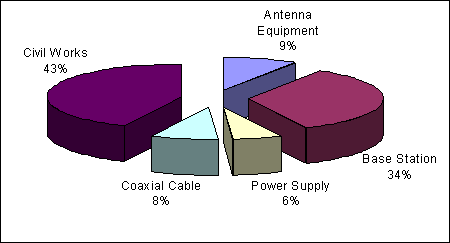Time to Check in at the Base Station HotelThe high installation and opex costs associated with cellular networks continue to inhibit deployment of both 2G and 3G systems
May 20, 2005

The mobile infrastructure sector had a good year in 2004, up between 15 and 20 percent from 2003 and worth about $50 billion worldwide. Declines in the price of base station equipment were offset by increases in volume, and despite the specter of cutthroat competition and predatory pricing, the outlook is sunny.
But it's not as great as it could be. The high installation and opex costs associated with cellular networks continue to inhibit deployment of both 2G and 3G systems, according to this month's Unstrung Insider report, Open Base Station Bonanza. Specifically, the construction and engineering costs involved with putting a base station onsite, and the opex costs to backhaul data traffic from 3G radio networks, must come down.
The chart below breaks out the cost distribution of a typical cell site installation. Most notable is that "Civil Works" accounts for about as much of the total site cost as the high-tech base station itself. The implication of this is that vendors have done a great job of developing cheaper and more efficient equipment over the years, but they will see diminishing returns from this type of innovation – unless they find a way to help operators claw back the costs involved in deploying and operating network infrastructure.
More evidence that the base station accounts for just a fraction of the cost of a cellular network comes from analysts at Credit Suisse First Boston Corp., who estimate that in 2005 the price of a base station will be around $33,000 (averaged over GSM, CDMA, and WCDMA technologies), while the "all-in" network cost per base station shipped will be around $148,000. By 2010, the analysts expect the average price per unit to have dropped 48 percent to $17,000 and the "all-in" cost to have dropped 40 percent to $90,000.
These figures jibe with other numbers quoted in the Insider report. Simon Swales, marketing manager at Powerwave Technologies Inc. (Nasdaq: PWAV), for example, estimates the cost of a typical Western European cell site at around €150,000 ($190,000); and analysts at Arete Research LLC peg the 2004 price of a 12-carrier GSM base station at around $10,000, while a three-carrier 3G node B was selling for between $20,000 and $25,000, with a target price on par with GSM by 2006.
The introduction of 3G could also see opex spiral upward. In 2G systems, operators typically backhaul TDM voice traffic over a T1/E1 leased line, and with just one line required per base station, this is a manageable cost. But the shift to 3G multiplies the amount of bandwidth required – potentially up to several Mbit/s per RF carrier when high-speed packet access is implemented, which swamps the 1.5-Mbit/s to 2-Mbit/s capacity of a T1/E1 line. And given that wireless data traffic inherently generates lower revenue per bit than voice services, it starts to get difficult for operators to justify the costs of leasing multiple T1/E1 lines to a site.
Most agree that the long-term solution to this leased-line headache is to run cheap, fat pipes out to the cell sites, which basically means using IP over Ethernet or some form of fixed wireless backhaul link. The catch is that the early cellular network standards specified TDM and ATM transport in the radio access network (RAN), with IP introduced only relatively recently – resulting in operators having to support multiple protocols.
One part of the answer to these high installation and leased-line costs could be the introduction of remote RF heads and "base station hotels," says the Unstrung Insider report.
The concept is that of a base station physically split in two parts: a remote RF head and a baseband radio server connected via a serial digital interface over fiber, as specified by the industry groups Common Public Radio Interface (CPRI) and Open Base Station Architecture Initiative (OBSAI). The result is a system that would see the baseband radio servers deployed in an easy-to-access location with the requisite backhaul, power, space, and security attributes, while the RF head could be mounted on the rooftop close to the antenna.
Advantages to this approach include the creation of an outsourced market for developers of integrated RF modules, which drives efficiency and flexibility for vendors – and, in turn, operators. In addition, there are major benefits that flow from replacing heavy and expensive coaxial cable with relatively lightweight and flexible fiber, and further benefits from reducing the cooling and power requirements in the base station cabinet.
Taken a stage further, multiple baseband radio servers could be deployed in one central location, where they could share power supplies and backhaul transport, while the RF heads could be distributed at optimal locations in the surrounding area. This idea of a base station hotel, coupled with distributed RF, certainly has barriers to adoption, but it also has enough potential to reduce installation and opex costs that it's worth further investigation.
— Gabriel Brown, Chief Analyst, Unstrung Insider
The report, Open Base Station Bonanza, is available as part of an annual subscription (12 monthly issues) to Unstrung Insider, priced at $1,350. Individual reports are available for $900. To subscribe, please visit: www.unstrung.com/insider.
You May Also Like








